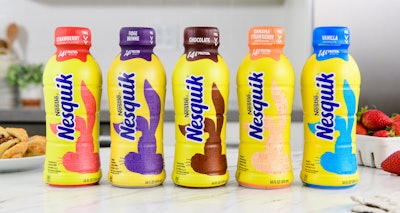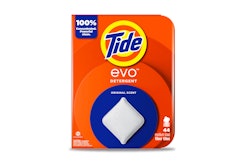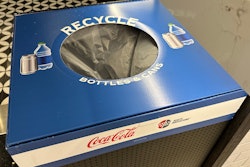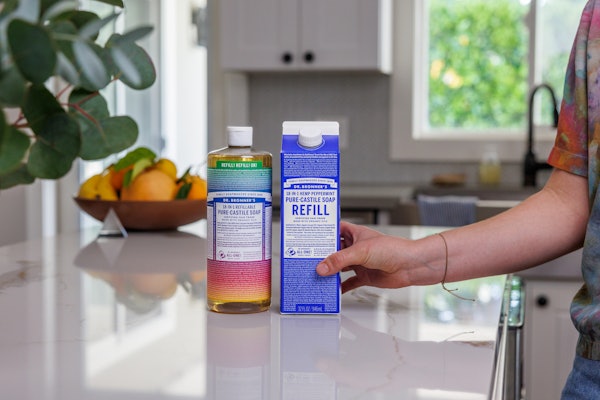
When it comes to design for recycling for beverage bottles, the right label can mean all the difference in accurate sorting at a municipal recycling facility (MRF) and the quality of the recyclate that results. Shrink-sleeve labels can be especially problematic, depending on the material used. It can also hinder MRF sorting technology from identifying the plastic material underneath.
For Nestlé’s Nesquik ready-to-drink portfolio of flavored dairy beverages, the problem was compounded by the need for a light-blocking label material. However, in mid-April, the brand announced the development of a new label material that provides the required functionality and is compatible with the U.S. recycling stream. The shrink-sleeve label will be available on all Nesquik RTD bottles this summer, making it Nestlé’s first product on-shelf with a recyclable shrink sleeve that leverages light-blocking technology.
Explains Nestlé, “The new shrink sleeve is made with materials that allow the bottle and sleeve to be recycled together, with the ambition that the packaging material can be reincorporated with the plastic supply stream and made into another PET bottle, helping create a circular economy for packaging.”
 | Read this related article on how brands and MRFs can work together to develop recyclable packaging: “PRS23: Collaboration is Key to Driving Recycling Success” |
With the new sleeve, the entire Nesquik bottle will be fully recyclable, meaning consumers can put the entire package, including cap, bottle, and shrink sleeve, into their recycling bin without the need to remove the sleeve.
All seven Nesquik RTD flavors are expected to convert to the new sleeve by June 2024. With this transition, an estimated 4,500 metric tons of PET plastic will be easier for consumers to recycle each year and more likely to be sorted accurately at recycling facilities.
Light-blocking attributes to ensure product quality
Nestlé is working across its portfolio to make all of its packaging recyclable or reusable, yet, as it explains, the path to a circular economy for food and beverage packaging comes with unique considerations. Developing a recyclable solution for the brand’s shrink sleeve posed a significant technical challenge, given the need for the light-blocking material. Nesquik’s milk-based beverage has attributes that are susceptible to light, such as taste, color, and vitamin-level.
When Nestlé first set out to transition its Nesquik bottles to a recyclable sleeve in 2019, there was no recyclable solution available in the market that also leveraged the light-blocking features required for the product.
“Packaging protects food and beverages and helps ensure our products remain high-quality for our consumers,” says Chastity McLeod, vice president of sustainability, Nestlé North America. “It was essential to find a solution that would maintain the quality and shelf life of the product, while also offering the benefit of making recycling the bottle easier for consumers. Our teams are constantly innovating to extend the use of packaging materials as a valuable resource that can be leveraged again. This innovation is a big step forward as we continue to drive progress on Nestlé’s packaging ambitions across our U.S. portfolio.”
Five years of R&D to bring the solution to life
The solution took nearly five years to bring to life. Nestlé began the process in late 2019 with conversations with multiple packaging suppliers, exploring different materials, light transmittance, and aesthetics.
A number of tests were conducted to ensure the technical viability across all seven Nesquik flavors. This included light transmittance tests across more than 20 candidate materials, product shelf-life studies, and the completion of plastics recyclability tests to ensure the new shrink sleeve and inks would remain compatible with the U.S. recycling system. These tests included ensuring the sleeved bottle would sort correctly when arriving at local MRFs, and testing the inks to ensure they would wash off, so that the bottle and sleeve material could be turned into recycled plastic for future use.
 | Read about another sustainable packaging innovation from Nestlé in this related article, “Nestlé Pilots Paper-Based, Home-Compostable Coffee Capsule” |
Nestlé also conducted factory trials to ensure the new sleeve would run effectively on its factory production lines, making adjustments to optimize both the shrink sleeve and existing factory equipment throughout the process. In addition, the team also trialed multiple iterations of shrink-sleeve artwork and ink combinations to ensure the new sleeve maintained Nesquik’s authentic look and feel.
Driving the industry forward in more sustainable packaging
According to Nestlé, the new shrink sleeve enables the company to continue driving packaging progress across its beverage portfolio. “Our beverage division continues to be a leader in delivering high-quality, innovative products for our consumers, while also driving progress on Nestlé’s sustainability ambitions,” says Daniel Jhung, president of Nestlé USA’s beverage division. “It’s exciting to see Nesquik at the forefront of this packaging innovation. Making our products easier to recycle is important to our customers and consumers, and a key step in helping chart a path to a circular economy for packaging.”
Some Coffee mate and natural bliss products will also be produced in this new shrink sleeve, and Nestlé Sensations flavored milk products are expected to convert to the new sleeve in early fall. Later this year, Nestlé plans to share more on its efforts and progress within its beverage portfolio to help promote a circular economy for packaging. PW























